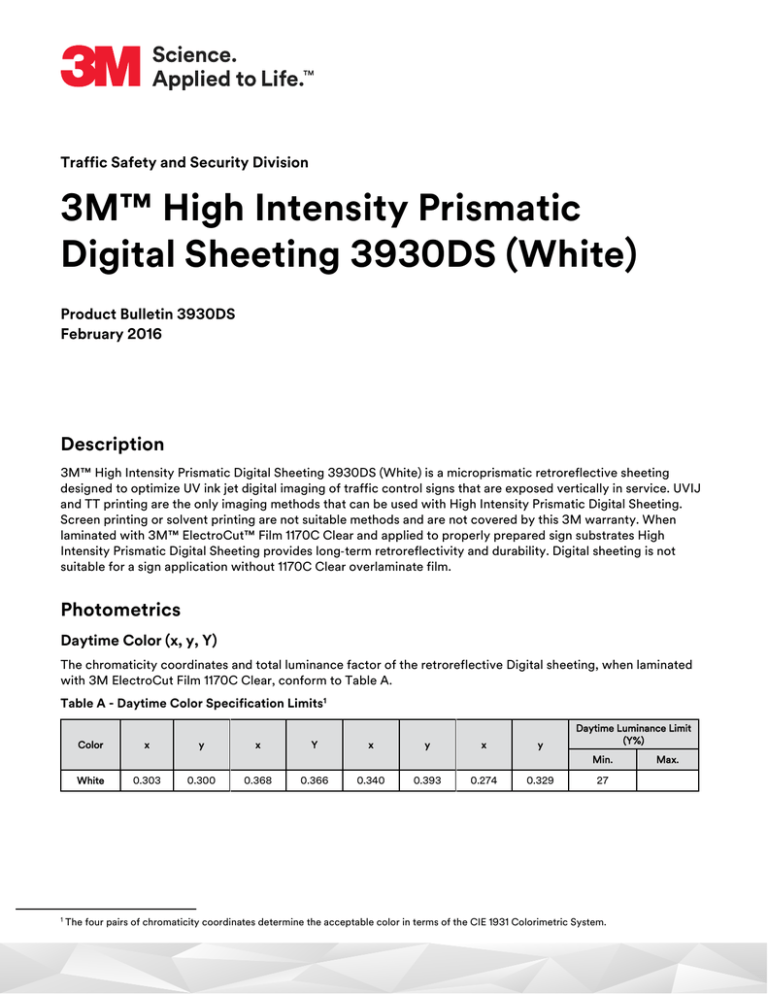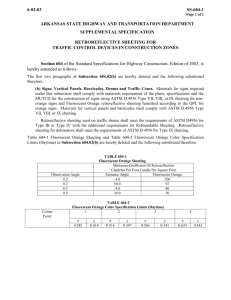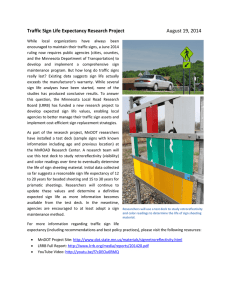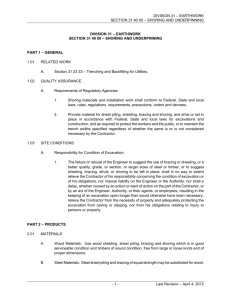
Traffic Safety and Security Division
3M™ High Intensity Prismatic
Digital Sheeting 3930DS (White)
Product Bulletin 3930DS
February 2016
Description
3M™ High Intensity Prismatic Digital Sheeting 3930DS (White) is a microprismatic retroreflective sheeting
designed to optimize UV ink jet digital imaging of traffic control signs that are exposed vertically in service. UVIJ
and TT printing are the only imaging methods that can be used with High Intensity Prismatic Digital Sheeting.
Screen printing or solvent printing are not suitable methods and are not covered by this 3M warranty. When
laminated with 3M™ ElectroCut™ Film 1170C Clear and applied to properly prepared sign substrates High
Intensity Prismatic Digital Sheeting provides long‐term retroreflectivity and durability. Digital sheeting is not
suitable for a sign application without 1170C Clear overlaminate film.
Photometrics
Daytime Color (x, y, Y)
The chromaticity coordinates and total luminance factor of the retroreflective Digital sheeting, when laminated
with 3M ElectroCut Film 1170C Clear, conform to Table A.
Table A - Daytime Color Specification Limits1
Color
x
y
x
Y
x
y
x
y
Daytime Luminance Limit
(Y%)
Min.
White
0.303
0.300
0.368
0.366
0.340
0.393
0.274
0.329
27
1
The four pairs of chromaticity coordinates determine the acceptable color in terms of the CIE 1931 Colorimetric System.
Max.
2
3M™ High Intensity Prismatic Digital Sheeting 3930DS (White)
February 2016
Color Test – Ordinary Colored Sheeting
Conformance to standard chromaticity (x, y) and luminance factor (Y %) requirements shall be determined by
instrumental method in accordance with ASTM E 1164 on sheeting applied to smooth aluminum test panels cut
from Alloy 6061‐T6 or 5052‐H38. The values shall be determined on a HunterLab ColorFlex 45/0
spectrophotometer. Computations shall be done for CIE Illuminant D65 and the 2º standard observer2.
Coefficients of Retroreflection (RA)
When laminated with 3M™ ElectroCut™ Film 1170C Clear, the values in Table B are minimum coefficients of
retroreflection expressed in candelas per lux per square meter (cd/lux/m2) for unprinted areas.
Test for Coefficients of Retroreflection
Conformance to coefficient of retroreflection requirements shall be determined by instrumental method in
accordance with ASTM E‐810 “Test Method for Coefficient of Retroreflection of Retroreflective Digital
Sheeting”, and per E‐810 the values of 0º and 90º rotation are averaged to determine the RA in Table B.
Table B - Minimum Coefficient of Retroreflection RA for new sheeting (cd/lux/m2)
Observation Angle3
0.2º
0.5º
-4º Entrance Angle4
360
150
30º Entrance Angle4
170
72
Entrance Angularity Performance in Regard to Orientation
High Intensity Prismatic Digital Sheeting is designed to be an effective wide angle reflective sheeting regardless
of its orientation on the substrate or ultimate orientation of the sign after installation. However, because the
efficiency of light return from cube corner reflectors is not equal at all application orientations, especially with
increasing entrance angles, it is possible to get the widest entrance angle light return when the sheeting is
oriented in a particular manner. When high entrance angle (>50º) performance is required for given signs (e.g.
Keep Right Symbols), it can be obtained easily by specifying the application orientation of the completed signs.
In these situations the completed sign should have the sheeting positioned at the 0º orientation (downweb
direction perpendicular to the road). When the flat side of the diamond (direction of diamond chain links) is
vertical in the completed sign, sheeting is said to be at a 0º orientation. When the “primary groove line” (or, flat
side of the diamond shape) is horizontal in the completed sign, the sheeting is said to be at a 90º orientation.
(Figure 1)
Figure 1 - Primary Groove Line
Unless the sign location and/or position calls for extra-wide entrance angularity performance or a specific
installation direction is required by customer specification, signs and applied copy (letters, arrows, borders and
shields) can be fabricated and installed using the application orientation that most efficiently utilizes the
reflective sheeting.
2
The instrumentally determined color values of retroreflective sheeting can vary significantly depending on the make and model of
colorimetric spectrophotometer as well as the color and retroreflective optics of the sheeting (David M. Burns and Timothy J.
Donahue, Measurement Issues in the Color Specification of Fluorescent Retroreflective Materials for High Visibility Traffic Signing
and Personal Safety Applications, Proceedings of SPIE: Fourth Oxford Conference on Spectroscopy, 4826, pp. 39‐ 49, 2003). For
the purposes of this document, the HunterLab ColorFlex 45/0 spectrophotometer shall be the referee instrument.
3
Observation Angle – The angle between the illumination axis and the observation axis.
4
Entrance Angle – The angle from the illumination axis to the retroreflector axis. The retroreflector axis is an axis perpendicular to the
retroreflective surface.
3
3M™ High Intensity Prismatic Digital Sheeting 3930DS (White)
February 2016
Note: For multi-panel signs it is recommended that all background panels be sheeted such that the sheeting
direction is the same for all panels.
Fabrication Lines
The manufacture of prismatic sheeting results in lines being present in the product. In High Intensity Prismatic
Digital Sheeting these lines are slightly thicker than the seal pattern legs. Fabrication lines are noticeable in shop
light but are not observable on the road either in daylight or at night under typical use conditions (Figure 2).
Figure 2 - Fabrication Lines
Adhesive
High Intensity sheeting has a pressure sensitive adhesive that is recommended for application at temperatures of
65ºF (18ºC) or higher.
Digital Printing Process
Prior to printing regulated traffic sign images on High Intensity Prismatic Digital Sheeting 3930DS, the printing
file must use only spot color swatches defined with the 3M™ naming convention. These files may then be
printed using only 3M™ Piezo Inkjet Series 8900UV Ink with an EFI H1625-RS printer.
Overlamination Process
High Intensity Prismatic Digital Sheeting 3930DS must be laminated with 3M™ ElectroCut Film 1170C Clear with
a pneumatically adjusted, heated top roll laminator. The laminator roll must be a minimum of 48 inches in width.
Due to high variations in the available laminator market, individual equipment and applications should be
evaluated by the customer for suitability and to identify optimal settings. Always follow manufacturer’s
instructions and safety recommendations. Optimal settings will eliminate defects such as bubbling, silvering,
curling and optics damage. Recommended settings vary by make and model. See examples below.
Table C
Make/Model
AGL/64T
AGL/Patriot
Nip Roll Temperature (°F)
155
155
Nip Roll Pressure (PSI)
65
20
Laminate Unwind Roll Pressure (PSI)
20
50
Laminate Liner Wind Up Roll Pressure (PSI)
5
50
Speed (ft/min)
2
3
4
3M™ High Intensity Prismatic Digital Sheeting 3930DS (White)
February 2016
Sign Fabrication Methods
Application
High Intensity Prismatic Digital Sheeting 3930DS incorporates a pressure sensitive adhesive and should be
applied to the sign substrate at temperature of 65ºF/18ºC or higher by any of the following methods:
Mechanical squeeze roll applicator – refer to 3M Information Folder (IF) 1.4. Application to extrusions that are
edge wrapped requires sufficient softening of the sheeting. This can be accomplished by directing additional
heat to the “next to last” edge roller. This practice will increase productivity and minimize cracking.
Hand squeeze roll applicator – refer to 3M IF 1.6.
Application of High Intensity Prismatic Digital Sheeting 3930DS (White) for complete signs or backgrounds must
be done with a roll laminator, either mechanical or hand driven.
Hand Application
Hand application is recommended for legend and copy only. Refer to 3M Information Folder 1.5 for more details.
Hand applications will show some visual irregularities, which are objectionable to aesthetically critical
customers. These are more noticeable on darker colors. To obtain a close-up uniform appearance, a roll
laminator must be used. All direct applied copy and border MUST be cut at all metal joints and squeegeed at the
joints.
Splices
High Intensity Prismatic Digital Sheeting 3930DS must be butt spliced when more than one piece of sheeting is
used on one piece of substrate. The sheeting pieces should not touch each other. This is to prevent buckling as
the sheeting expands in extreme temperature and humidity exposure.
Double Faced Signs
The sheeting on the bottom side of a double faced sign can be damaged if rolled through a squeeze roll
applicator with an unprotected steel bottom roller. The use of a semi-soft flat sheet between the steel roller and
the applied sign face will provide protection from damage. A material such as a rubber mat, tag board or
cardboard is recommended.
Substrates
For traffic sign use, substrates found to be most reliable and durable are properly prepared aluminum sheets and
extrusions. Users are urged to carefully evaluate all other substrates for adhesion and sign durability. Other
substrates that may be satisfactory for proper application of sheeting will have the following characteristics:
– Clean
– Smooth
– Flat
– Rigid
– Dimensionally stable
– Weather resistant
– Non-porous
– High surface energy (passes water break test)
Refer to Information Folder 1.7 for surface preparation recommendations. Substrates with low surface energy
may require additional preparation such as flame treatment, mechanical abrasion or use of adhesion
promoters prior to sheeting application. Guide sign extrusions may be edge wrapped. Flat panels or
unwrapped extrusions are to be carefully trimmed so that sheeting from adjacent panels does not touch on
assembled signs. High Intensity Prismatic Digital Sheeting 3930DS is designed primarily for applications to
flat substrates. Any use that requires a radius of curvature of less than five inches should also be supported
by rivets or bolts. Plastic substrates are not recommended where cold shock performance is required. Sign
failures caused by the substrate or improper surface preparation are not the responsibility of 3M.
5
3M™ High Intensity Prismatic Digital Sheeting 3930DS (White)
February 2016
Applying Cut-Out Copy
3M™ High Intensity Prismatic Digital Sheeting 3930DS (White) may be processed into traffic signs by applying cut‐
out copy as described below. 3M assumes no responsibility for failure of sign face legends or backgrounds that have been processed with materials other than the matched component imaging materials listed in Table D.
Table D – Matched Component Materials compatible with High Intensity Prismatic Digital Sheeting 3930DS
Matched Components
ElectroCut™ Film
1170C Clear
Digital Imaging
8900UV
Slipsheet
SCW 568
Prespacing Tape
SCPS-2
Premasking Tape
SCPM-3
Transfer Tape
TPM-5
Applied Cut-Out Copy
High Intensity cut letters may be applied to High Intensity Prismatic Digital Sheetig 3930DS to create a sign legend. Direct applied copy must be cut at all panel seams and carefully trimmed back so that sheeting from adjacent panels do not touch each other on assembled signs. Refer to Information Folder 1.10 for more information.
Storage and Packaging
High Intensity Prismatic Digital Sheeting 3930DS (White) should be stored in a cool, dry area, preferably at 6575ºF (18-24ºC) and 30-50% relative humidity and should be applied within one year of purchase. Rolls should be
stored horizontally in the shipping carton. Partially used rolls should be returned to the shipping carton or
suspended horizontally from a rod or pipe through the core. Unprocessed sheets should be stored flat. Finished
signs and applied blanks should be stored on edge.
Avoid banding, crating, or stacking signs. Package for shipment in accordance with commercially accepted
standards to prevent movement and chafing. Store sign packages indoors on edges.
Panels or finished signs must remain dry during shipment and storage. If packaged signs become wet, unpack
immediately and allow signs to dry. Refer to Information Folder 1.11 for instructions on packing for storage and
shipment.
Installation
Nylon washers are required when twist style fasteners are used to mount the sign.
Cleaning
Signs that require cleaning should be flushed with water, and then washed with a detergent solution and soft
bristle brush or sponge. Avoid pressure that may damage the sign face. Flush with water following washing. Do
not use solvents to clean signs. Refer to 3M Information Folder 1.10 for more information.
Health and Safety Information
Read all health hazard, precautionary, and first aid statements found in the Safety Data Sheets (SDS) for
important health, safety and environmental information. To obtain SDS sheets for 3M products, go to
3M.com/SDS, or by mail, or in case of an emergency, call 1-800-364-3577.
6
3M™ High Intensity Prismatic Digital Sheeting 3930DS (White)
February 2016
Warranty Information
Warranty Coverage Overview
The durability of 3M™ High Intensity Prismatic Digital Sheeting 3930DS (White) and finished signs will depend
upon substrate selection and preparation, compliance with recommended application procedures, geographic
area, exposure conditions, and maintenance. Maximum durability of 3930DS (White) sheeting can be expected
in applications subject to vertical exposure on stationary objects when processed and applied to properly
prepared aluminum according to 3M recommendations provided in Information Folder 1.7 on Sign Substrate
Surface Preparation. The user must determine the suitability of any nonmetallic sign backing for its intended use.
Sign failures caused by the substrate or improper surface preparation are not the responsibility of 3M.
Applications to unprimed, excessively rough or non‐weather‐resistant surfaces, or exposure to severe or unusual
conditions can shorten the performance of such applications. Signs in mountainous areas that are covered by
snow for prolonged periods may also have reduced durability. Atmospheric conditions in certain geographic
areas may result in reduced durability.
Periodic sign inspection and regular sign replacement are strongly recommended in order for agencies to
establish their own effective service life expectation.
3M Basic Product Warranty
3M High Intensity Prismatic Digital Sheeting 3930DS (“Product”) is warranted (“Basic Warranty”) to be free of
defects in materials and manufacture at the time of shipment and to meet the specifications stated in this
product bulletin. If the Product is proven not to have met the Basic Product Warranty on its shipment date, then
a buyer’s exclusive remedy, and 3M’s sole obligation, at 3M’s option, will be refund or replacement of the
Product.
3M MCS™ Warranty, MCS Warranty for Traffic, and Limited Remedy
For the MCS Warranty, MCS Warranty for Traffic, and limited remedies applicable to the Product, refer to the
3M™ Digitally-Imaged Sign Warranty Bulletin.
Limitations of Liability
3M WILL NOT UNDER ANY CIRCUMSTANCES BE LIABLE TO A BUYER FOR DIRECT (other than the applicable
Limited Remedy previously stated), SPECIAL, INCIDENTAL, INDIRECT OR CONSEQUENTIAL DAMAGES
(INCLUDING, WITHOUT LIMITATION, LOSS OF PROFITS) IN ANY WAY RELATED TO A PRODUCT OR THIS
PRODUCT BULLETIN, REGARDLESS OF THE LEGAL OR EQUITABLE THEORY ON WHICH SUCH DAMAGES
ARE SOUGHT.
Additional Limitations
See the 3M™ Digitally-Imaged Sign Warranty Bulletin for terms, additional limitations of your warranty, if any,
and limitations of liability.
Other Product Information
Always confirm that you have the most current version of the applicable Product Bulletin, Information Folder or
other product information from the 3M Website at http://www.mmm.com/tss.
IF 1.4 Instructions for Interstate Squeeze Roll Applicator
IF 1.5 Hand Application Instructions
IF 1.6 Hand Squeeze Roll Applicator
IF 1.7 Sign Base Surface Preparation
IF 1.10 Cutting, Premasking, and Prespacing
IF 1.11 Sign Maintenance Management
PB 1170 ElectroCut™ Film Series
For Information or Assistance
Call: 1-800-553-1380
In Canada Call:
1-800-265-1840
Internet:
www.3M.com/roadwaysafety
3M, ElectroCut and MCS are trademarks of 3M. Used under license in Canada.
ColorFlex is a registered trademark of Hunter Associates Laboratory, Inc. 3M assumes no responsibility for any injury, loss or damage arising out of the use of a product that is not of our manufacture. Where
reference is made in literature to a commercially available product, made by another manufacturer, it shall be the user’s responsibility to
ascertain the precautionary measures for its use outlined by the manufacturer.
Important Notice
All statements, technical information and recommendations contained herein are based on tests we believe to be reliable, but the accuracy
or completeness thereof is not guaranteed, and the following is made in lieu of all warranties, or conditions express or implied. Seller’s and
manufacturer’s only obligation shall be to replace such quantity of the product proved to be defective. Neither seller nor manufacturer shall
be liable for any injury, loss or damage, direct, special or consequential, arising out of the use of or the inability to use the product. Before
using, user shall determine the suitability of the product for his/her intended use, and user assumes all risk and liability whatsoever in
connection therewith. Statements or recommendations not contained herein shall have no force or effect unless in an agreement signed by
officers of seller and manufacturer.
Traffic Safety and Security Division
3M Center, Building 0225-04-N-14
St. Paul, MN 55144-1000 USA
Phone 1-800-553-1380
Web 3M.com/roadwaysafety
Please recycle. Printed in USA © 3M 2016.
All rights reserved. Electronic Only



